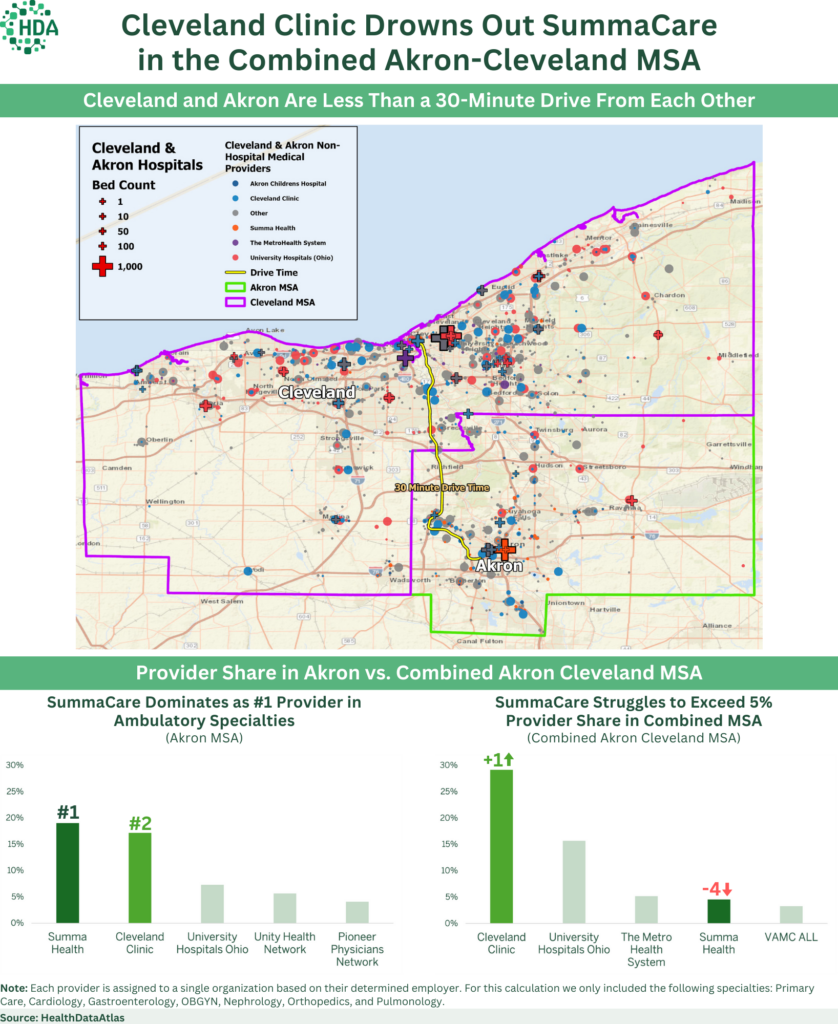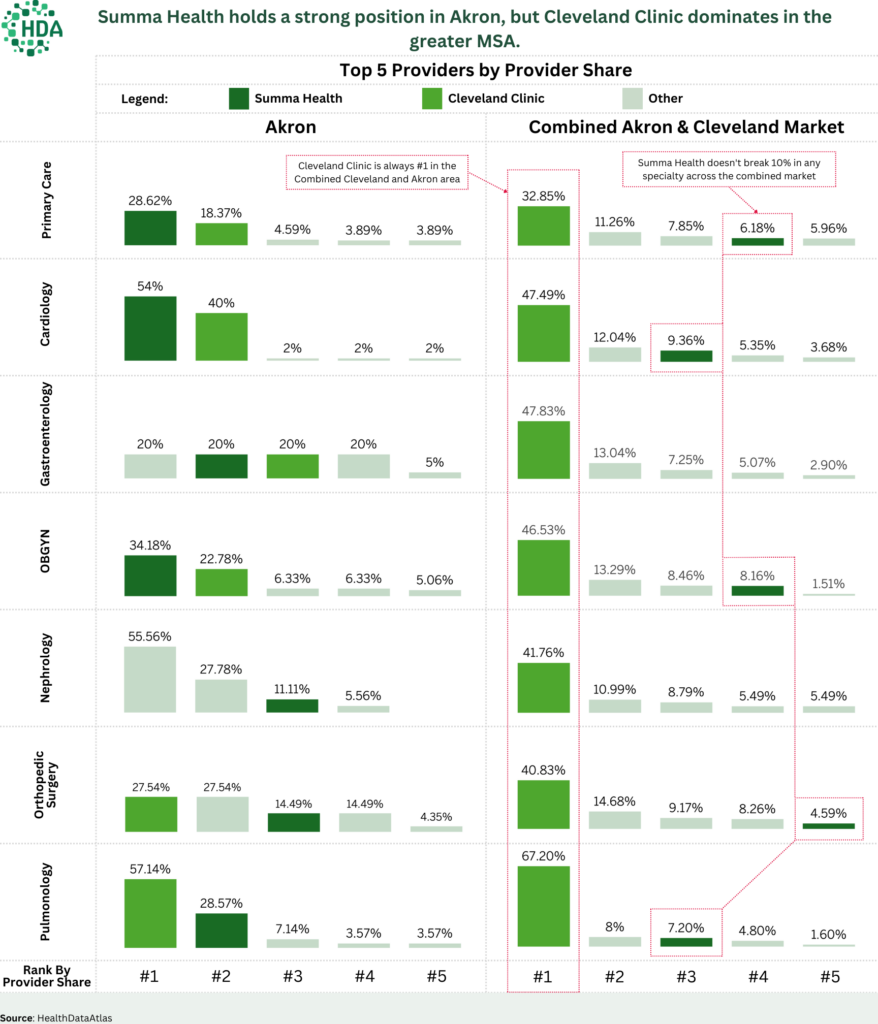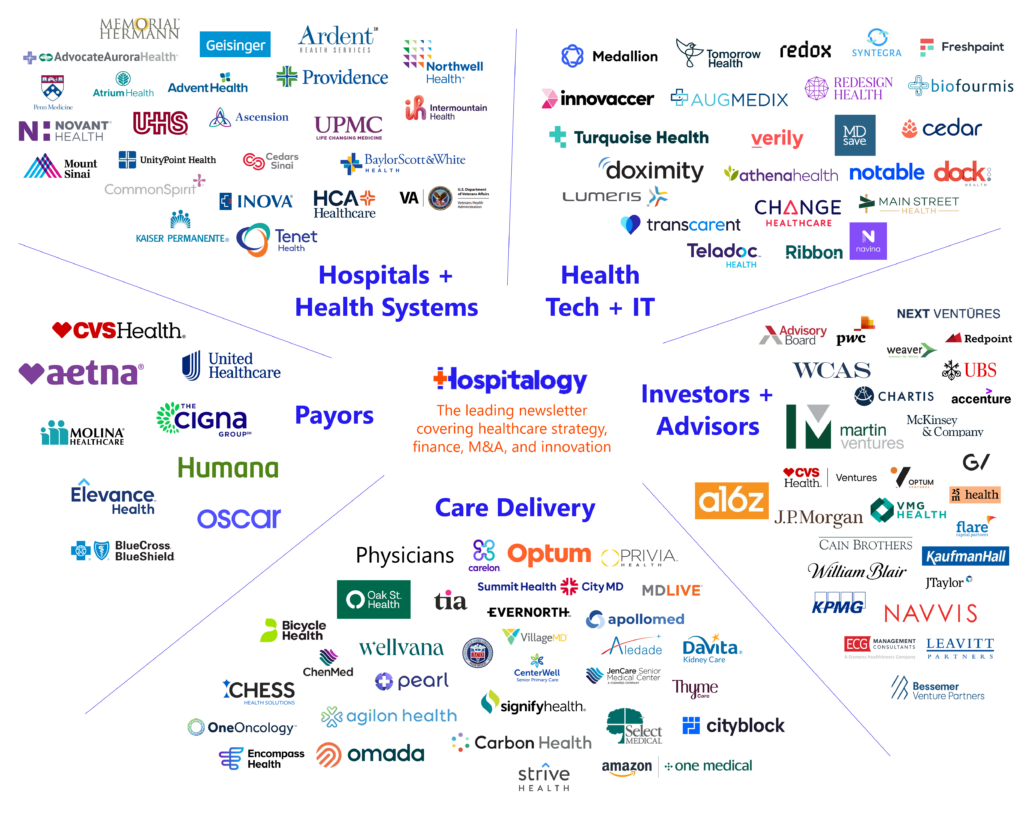Hospitalogists,
I’m happy to be joined once again by Health Data Atlas founder and Board Room member Michael Stratton. We’ve been chatting for a while about the interesting nontraditional health system deals going on (HATCo and Risant) and thought it would be worthwhile to put forth some of our thoughts around potential strategies along with analysis around the provider markets, which also might hint at future plans involving health system transformation.
So, today we’re diving into General Catalyst, HATCo, and their acquisition of Summa Health!
HATCo – a Marketing Ploy, or a Serious Health System Transformation Vehicle?
Is General Catalyst’s acquisition of Summa Health all for marketing and brand recognition? Or does HATCo – led by former Intermountain CEO Marc Harrison – hold much larger ambitions…say, perhaps, to turn it into the Intermountain of the east?
Some rumors have swirled that the move is an attempt to attract companies needing an early health system partner. Others have hypothesized it’ll give their portfolio companies a better fighting chance against incumbents like Epic (unlikely.)
While it’s still unclear what their actual intentions from the outside looking in, we’re going to explore the facts including an in depth analysis of their current market position and what options that may have for future growth.
Based in Akron, Ohio, Summa Health offers an impressive full spectrum of well regarded services, including a full-service hospital, a dedicated physician group, a payer, and an ACO. In other words, the chassis for health system transformation is there, and seems to be working relatively well for the health system in Akron. The problem is…Summa Health is more or less squeezed on all sides geographically.
Most notably, they’re only a 30 minute drive from the world-renowned Cleveland Clinic. This competitive dynamic, along with other health system presences in the greater area, poses a unique challenge as the traditional paths available to health systems through providing higher acuity, sub-specialist level services and/or growing out more extensive ambulatory networks in the more densely populated regions of northern Ohio is likely not their best strategy.
Summa Health’s Challenging Market Position
The landscape that GC/HATCo steps into is described in the two images below.
This map lays bare Summa Health’s challenge: while it serves as a cornerstone in Akron, the density of services in Cleveland, including the prominent Cleveland Clinic, saturate the overall market.

It also shows that for key specialties, Summa Health is a dominant, central player in Akron’s provider market. Summa Health’s large provider share in the below key specialties is a testament to their significant presence in the Akron market.
But when extending this analysis to include a greater geographic area, Summa Health’s stronghold in Akron has an obvious, diminished influence in the overall market. The vast network of the Cleveland Clinic becomes more pronounced. As seen below, the combined Summa Health’s provider market share in the combined Akron and Cleveland markets shrinks significantly for key specialties:

So how do you compete? What do you do if you’re legacy Summa Health in a position like this? These factors almost assuredly explain why Summa felt the need to find a partner for capital and growth purposes, and the health system found just that in HATCo – which is willing to take a bold bet on the Akron market to improve Summa’s operations and find creative growth avenues. The situation at present sets the stage for strategic initiatives that may leverage Summa Health’s strengths and address areas where there’s room for growth and improvement.
What does this mean for HatCo’s options?
While folks in Akron are likely familiar with the Summa Health name, most people in the broader Cleveland-Akron market with any sort of higher acuity condition are going to Cleveland Clinic. Wouldn’t you?
So, with that in mind, and as mentioned earlier in this piece, the traditional health system ‘heads in beds’ path of growing fee-for-service volumes and attracting higher acuity sub-specialty services may not end well. Summa would be better off acknowledging core competencies and ceding most of this lucrative market to the Cleveland Clinics of the world.
Join the thousands of healthcare professionals who read Hospitalogy
Subscribe to get expert analysis on healthcare M&A, strategy, finance, and markets.
No spam. Unsubscribe any time.
Instead, we’d expect Summa Health – under HATCo’s guidance – to follow in a similar path to Intermountain. And given who runs HATCo, it’s really not a leap of faith at all to expect this shift in Summa Health’s operation. With $16B+ in revenues, Intermountain is in a much better situation than Summa Health. The forward-thinking health system operates in better markets with faster-growing demographics, and is also diversified across the inpatient & outpatient book of business.
Still, there are a number of areas Intermountain’s influence will sway Summa Health. We expect to see initiatives in the following areas:
- Covering or prioritizing rural areas that aren’t as enticing to others and shift their focus toward value-based care models, with technology enabling scalability here
- Growing Summa’s risk opportunities and advancing capabilities needed to succeed in population health initiatives – using best practices learned from SelectHealth and Castell
- Leveraging GC and HATCo portfolio companies / best practices in areas like labor retention, clinical satisfaction, culture, and simplification of administrative functions at the enterprise level
While the rural market would likely focus on Medicare Advantage, the Akron market itself is ripe with a growing Managed Medicaid opportunity. This emerging market provides the perfect opportunity for technology (and GC’s portfolio companies) to shine.
The hiring of Marc Harrison and other seasoned health system veterans shows General Catalyst – and HATCo – are serious about the path they’re heading down. While health system transformation is a huge buzzword right now, we’re excited to see whether HATCo can truly move the needle for a health system in desperate need of its next phase of growth. In 10 years, will we look to Summa Health and witness its emergence as an outperforming, forward-thinking health system model of tomorrow?
What are your thoughts on Summa Health, and General Catalyst’s bold play? We know it’s yesterday’s news, but between HATCo and Risant, the moves made in 2024 hold the potential to reshape the health system landscape in a significant, innovative way over the coming decades.
Thanks for reading! Subscribe to Hospitalogy, my newsletter breaking down healthcare finance, M&A, and strategy twice weekly. Join 33,000+ executives and investors from leading healthcare organizations by subscribing here!

